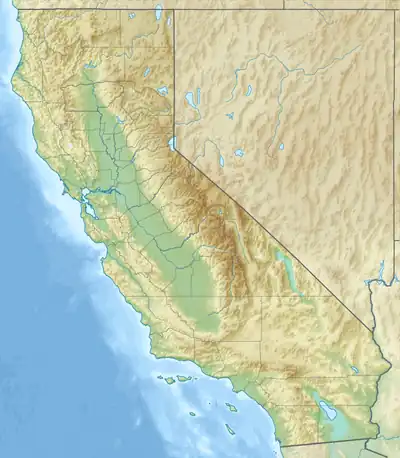Iron Gate Dam (California)
Iron Gate Dam is an earthfill hydroelectric dam on the Klamath River in northern California, outside Hornbrook, California, that opened in 1964. The dam blocks the Klamath River to create the Iron Gate Lake Reservoir. It is the lowermost of a series of power dams on the river, the Klamath River Hydroelectric Project, operated by PacifiCorp. It also poses the first barrier to migrating salmon in the Klamath. The Iron Gate Fish Hatchery was placed just after the dam, hatching salmon and steelhead that are released back into the river.[1] The Iron Gate Dam (National ID CN 001223),[2] along with the John C. Boyle Dam, are two of four on the Klamath River that would be removed under the Klamath Economic Restoration Act.[3] As of February 2016, the states of Oregon and California, the dam owners, federal regulators, and other parties reached an agreement to remove all four dams by the year 2020, pending approval by the Federal Energy Regulatory Commission.[4] On February 25, 2022, the FERC released its final Environmental Impact Statement (EIS) on the dam's removal. The Iron Gate Dam is expected to be removed sometime in 2023 or 2024.[5] A movement to Un-Dam the Klamath has been ongoing for 20 years to remove the dams.[6][7]
| Iron Gate Dam | |
|---|---|
 Iron Gate Dam Iron Gate Dam (California) | |
| Country | United States |
| Location | Siskiyou County, California |
| Coordinates | 41°56′02″N 122°26′07″W |
| Opening date | 1964 |
| Dam and spillways | |
| Type of dam | Earthfill |
| Impounds | Klamath River |
| Height | 173 ft (53 m) |
| Length | 540 ft (160 m) |
| Spillway type | Concrete overflow |
| Reservoir | |
| Creates | Iron Gate Reservoir |
| Total capacity | 58,000 acre⋅ft (72,000,000 m3) |
| Catchment area | 4,630 sq mi (12,000 km2) |
| Surface area | 1,020 acres (410 ha) |
| Maximum water depth | 210 feet (64 m) |
| Power Station | |
| Turbines | 2 |
| Installed capacity | 18 MW |
| Annual generation | 112,650,000 KWh |
Iron Gate Reservoir
Iron Gate Reservoir is an artificial lake on the Klamath River in Siskiyou County, California, near the Oregon border of the United States. The lake's waters are impounded by the Iron Gate Dam and operated by PacifiCorp. It has an average depth of 70 feet (21.4 m).[8]
The Iron Gate Reservoir is host to several recreation activities. There are several campsites on the Western side of the reservoir. Some campsites, such as Mirror Cove and Juniper Point, are open from May to October. Others, such as Camp Creek, are open year-round. All campsites are free to use.[9] Each site has a launch point, allowing for boating, kayaking, and swimming on the reservoir. The reservoir contains yellow perch, trout, largemouth bass, catfish, and native rainbow trout, which makes it a popular fishing location.[10]
In 2020, the state released a danger warning about harmful blue-green algae (cyanobacteria) blooms. These blooms are toxic to humans and animals, so announcements were made warning against swimming in the reservoir and eating any fish from the reservoir.[11] There have been reports in the past, but no warnings have been made since. These algal bloom growths likely occurred due to lower water levels and increasing water temperatures.
References
- "Iron Gate Fish Hatchery".
- "USGS Current Conditions for USGS 11516530 KLAMATH R BL IRON GATE DAM CA". waterdata.usgs.gov. Retrieved 2022-04-30.
- Stillwater Sciences A Preliminary Evaluation of the Potential Downstream Sediment Deposition Following the Removal of Iron Gate, Copco, and J.C. Boyle Dams, Klamath River, CA Archived 2010-02-09 at the Wayback Machine Final Report Prepared for American Rivers, May 2004.
- Carolyn Lochhead (3 February 2016). "New plan to remove Klamath River dams without help from Congress". SFGate.
- "FERC Staff Issues the Draft Environmental Impact Statement for the Hydropower License Surrender and Decommissioning of the Lower Klamath Project No. 14803 (P-14803-001) | Federal Energy Regulatory Commission". www.ferc.gov. Retrieved 2022-04-30.
- Hartel, Diana (25 May 2011). "Doctor's Orders: Undam the Klamath". High Country News.
- "Dams Are Threatening California Salmon and a Native Tribe's Culture". VICE News. 22 October 2020.
- "Document Display | NEPIS | US EPA". nepis.epa.gov. Retrieved 2022-04-30.
- "Iron Gate Reservoir". Discover Siskiyou. Retrieved 2022-04-30.
- "#88 – Iron Gate Reservoir". 101 Things To Do Shasta Cascade. 2015-04-01. Archived from the original on August 10, 2020. Retrieved 2022-04-30.
- Kinkade, Skye. "Don't go in the water: dangerous algal blooms at Iron Gate, Copco reservoirs". Siskiyou Daily News. Retrieved 2022-04-30.
